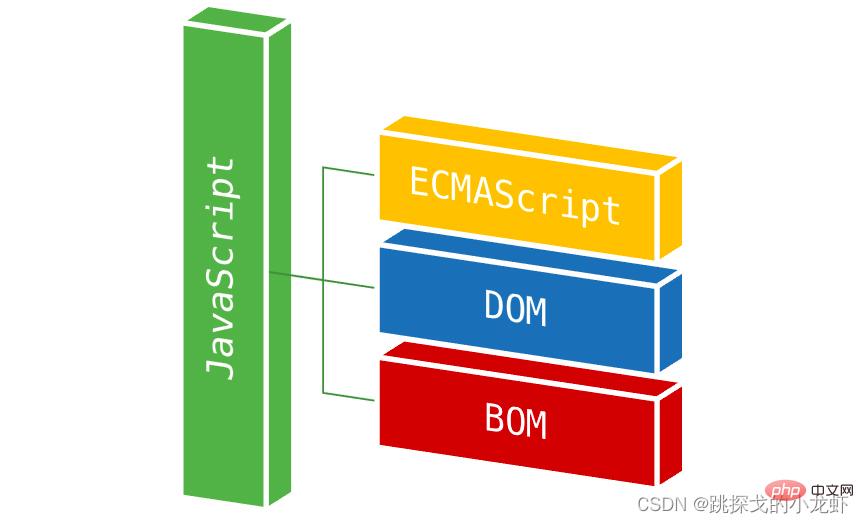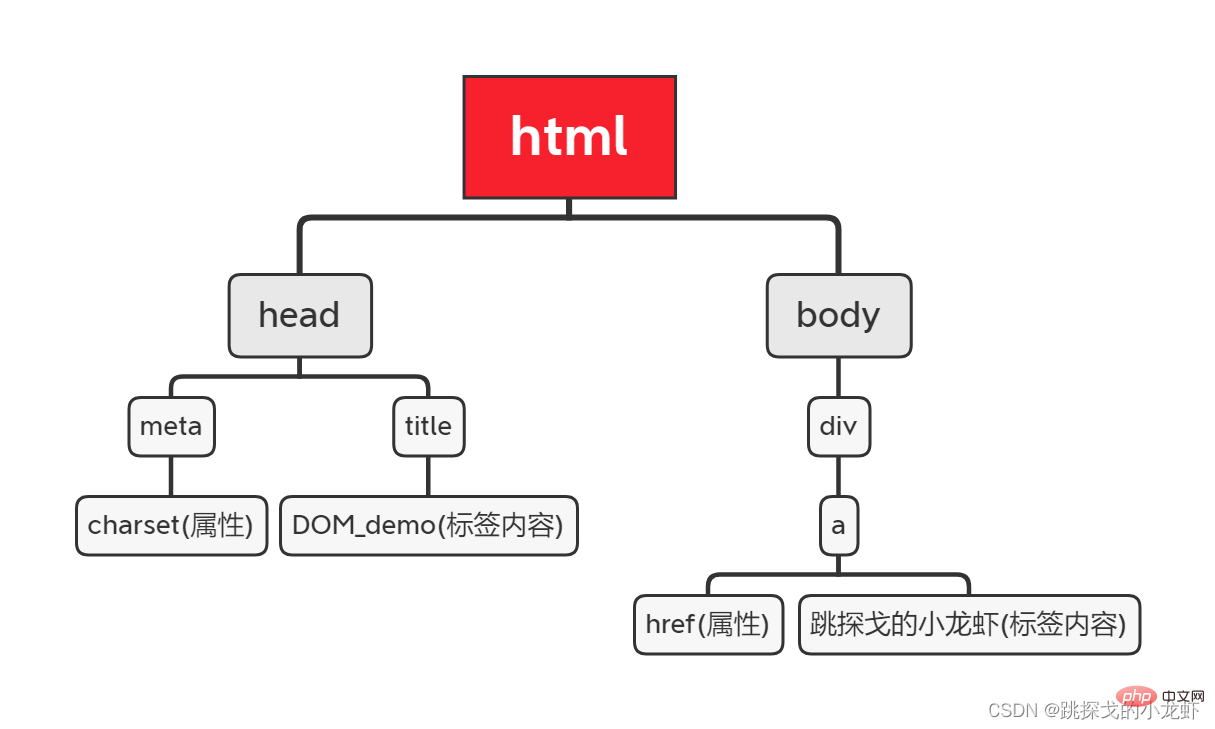
This article brings you relevant knowledge about javascript. It mainly introduces the difference and usage between DOM and BOM, and also includes some related operations. Let’s take a look. I hope it helps everyone.

[Related recommendations: javascript video tutorial, web front-end]
At the beginning of the article, I want to mention Generally speaking, What is DOM and what is BOM, because this article The article is ultimately intended for friends who have a certain foundation in JavaScript, but do not understand or even know about DOM and BOM.
However, before talking about what is DOM and what is BOM, please allow me to show you the entire structure of Javascript:

In the picture above, we can see that there are four elements: JavaScript, ECMAScript, DOM and BOM. So what is the connection between the four of them? Use an equation to summarize the relationship between them:
Let’sJavaScript = ECMAscript BOM DOM
compare them one by one To give an overview:
ECMAscript:
ECMAScript is a language adopted byECMA International (formerly the European Computer Manufacturers Association) ECMA-262 standardized scripting programming language,It is the standard for JavaScript (JS for short), and the browser is to implement this standard.
ECMAscript is more like a regulation that stipulates how each browser executes the syntax of JavaScript, because we know that JavaScript is a scripting language that runs on the browser! There are regulations, but we still lack a way to interact with each element on the page. At this time, the following DOM was born!
DOM:
DOM (One sentence summary:Document Object Model, Document Object Model) is a language independent, Application programming interface used to operate xml, html documents.
For JavaScript: In order toenable JavaScript to operate Html, JavaScript has its own DOM programming interface.
DOM provides a "method" for JavaScript to access and operate HTML elements(The reason why we don’t use the word interface is because we are afraid that some friends will see the interface It’s a scary situation, but in fact the most accurate description of is that it provides an interface for JavaScript)
BOM is
Browser Object Model, browser object modelBOM provides JavaScript with a "method" to control browser behavior.. BOM is an interface that appears to control the behavior of the browser. For JavaScript: In order to
allow JavaScript to control the behavior of the browser, JavaScript has its own BOM interface.
One sentence summary:
Finally, among the above three components of JavaScript,
ECMscript is a specification, while the other two provide "methods", respectively Corresponding to HTML elements and browsers, so below we will give a systematic explanation for the latter two: DOM and BOM. Since it is for beginners, my following explanation will be as simple as possible It’s easy to understand, even if you don’t have a basic knowledge, you can eat it with confidence!
, I will Divided into two pieces of content:
II.I DOM treeMaybe some beginners who have learned DOM will be a little unfamiliar with this word, but in fact, the DOM tree is not a particularly fantasy thing. On the contrary, for front-end staff,
The DOM tree is the tree composed of the HTML elements of the pages you deal with every day:
In BOM tree, Each node can have two identities: it can be a child node of the parent node, or it can be the parent node of other child nodes. Let’s observe the following paragraph together. Code :
<!DOCTYPE html> <html lang="en"> <head> <meta charset="UTF-8"> <title>DOM_demo</title> </head> <body> <p> <a href="https://blog.csdn.net/qq_52736131">跳探戈的小龙虾</a> </p> </body> </html>
The above code, its DOM tree should be like this:

At this time someone wants I asked, you said that the DOM tree for so long has something to do with operating html elements?
The answer is is very relevant, and only by understanding the DOM tree structure of the document can we accurately and effectively operate DOM elements , otherwise various unexpected bugs will appear. Before we operate the HTML elements of a page, we must have a clear drawing of the DOM of the entire page. Even if we are not actually drawing, we must have a clear context structure in our mind.
AboutSome common operations of DOM in JavaScript The method of html element, I have divided it into several sub-parts to introduce them to you:
//1.通过元素的id属性值来获取元素,返回的是一个元素对象 var element = document.getElementById(id_content) //2.通过元素的name属性值来获取元素,返回的是一个元素对象的数组 var element_list = document.getElementsByName(name_content) //3.通过元素的class属性值来获取元素,返回的是一个元素对象的数组 var element_list = document.getElementsByClassName(class_content) //4.通过标签名获取元素,返回的是一个元素对象数组 var element_list = document.getElementsByTagName(tagName)
//1.获取元素的属性值,传参自然地是属性名,例如class、id、href var attr = element.getAttribute(attribute_name) //2.设置元素的属性值,传参自然地是元素的属性名及要设置的对应的属性值 element.setAttribute(attribute_name,attribute_value)
//1.创建一个html的元素,传参是元素类型,例如p、h1-5、a,下以p为例
var element = document.createElement("p")
//2.创建一个文本节点,传参的是对应的文本内容(注意是文本节点,不是某个html元素)
var text_node = document.createTextNode(text)
//3.创建一个属性节点,传参是对应的属性名
var attr_node = document.createAttribute(attribute_name)
element.setAttributeNode(attr_node)Special attentionThe third method of creating attribute nodes must be matched with a specific element, that is, you mustget a specific element element first and create a Attribute node, finally add this attribute node (setAttributeNode) to this element.
//1.向element内部的最后面添加一个节点,传入的参数是节点类型 element.appendChild(Node) //2.向element内部某个已存在的节点的前面插入一个节点,仍然传入一个节点类型的参数 element.insertBefore(new_Node,existed_Node)
Note, Before adding a node, you need to Create the node first, and select the parent node element at the same time. The second method Even you have to find the sibling node behind the insertion position.
//删除element内的某个节点,传参是节点类型参数 element.removeChild(Node)
Note, When deleting, you must find the corresponding parent node element. Successfully deleted .
Some common DOM attributes:
//1.获取当前元素的父节点 var element_father = element.parentNode //2.获取当前元素的html元素型子节点 var element_son = element.children //3.获取当前元素的所有类型子节点,包括html元素、文本和属性 var element_son = element.childNodes //4.获取当前元素的第一个子节点 var element_first = element.firstChild //5.获取当前元素的前一个同级元素 var element_pre = element.previousSibling //6.获取当前元素的后一个同级元素 var element_next = element.nextSibling //7.获取当前元素的所有文本,包括html源码和文本 var element_innerHTML = element.innerHTML //8.获取当前元素的所有文本,不包含html源码 var element_innerTEXT = element.innerText
is that means to convert the html code and text in the element into text . The original html code is executed, and converting it into text is equivalent to Ordinary string!
limited space, BOM will not be explained in detail (its practicality is indeed not as great as DOM). Let’s review the introduction to BOM at the beginning:
BOM provides JavaScript with several "methods" to operate the browseruse a picture to sort out the structure of the entire BOM. Similar to the DOM, the BOM also has a tree structure:So first we

window is the top of the entire BOM tree food chaincommon properties and methods, so every newly opened window is considered a window object.
The window object has the following
: Among them, you can see that there is a function alert() on it, because when you learn JavaScript, the input and output streamsEveryoneMost of them use the alert() function pop-up window as their first demo, so when you see this you may ask: Used alert() When it comes to functions, it seems that window is not mentioned, so is the alert() here the same alert() that I learned before? The answer is this: two alert() are indeed the same function . The reason why window can be omitted is because all the properties and methods of window , can have two representation methods: (1) window.property/window.method() (2) direct property / Calling method () is not just alert(), all the above window properties and functions are established, and interested friends can try it by themselves. location object? The location object is a property of the window object, which provides information about the document loaded in the current window and also provides some navigation functions. In fact, if we carefully observe the structure diagram above, we will find: The location object is not only an attribute of the window object, but also an attribute of the document object. This means: ##window.location = location = document.location history object? The history object is an attribute of the window object. It saves the record of the user's Internet access. The timestamp of this record is calculated from the moment the window was opened. navigator object: The navigator object is the one in the BOM that identifies the client browser. window attribute.
Properties/Methods
Meaning
opener The parent window of the current window
length
The number of frames in the window
document
The document object currently displayed in the window
alert(string)
Create a warning dialog box and display a message
close()
Close the window
confirm()
Create a dialog box that requires user confirmation
open(url,name,[options])
Open a new window and return the new window object
prompt(text,defaultInput)
Create a dialog box to ask the user to enter information
setInterval(expression, milliseconds)
Calculate an expression after a specified time interval
setInterval(function,millis enconds,[arguments])
Call a function after the specified time interval
setTimeout(expression,milli seconds)
Calculate an expression after the timer expires
setTimeout(expression,milli seconds,[arguments])
Calculate an expression after the timer expires Function
These
location object
What is the
The location object has the following common properties and methods:
##hostProperties/Methods
Content
hostnameHost name: port number
hrefHostname
Entire URL
##pathname Pathname
port Port number
protocol Protocol part
search Query string
reload() Reload the current URL
repalce() Replace the current page with the new URL
history object
What is the
The history object has the following common properties and methods:
Properties/Methods
Description
length
The number of records in the history object
back()
Go to the URL of the previous browser history entry, similar to back
forward()
Go to the next URL of browser history entry, similar to forward
go(num)
The browser moves forward or backward in the history object
navigator object
Finally introduce the
Some common properties related to navigator:
[Related recommendations:
Properties
Description
appName
Complete browser name and version information
platform
The system platform where the browser is located
plugins
Array of plug-in information installed in the browser
userAgent
The browser’s user agent string
userLanguage
The operating system’s default language
The above is the detailed content of In-depth understanding of DOM and BOM in JavaScript. For more information, please follow other related articles on the PHP Chinese website!